Effect of seasonality on the seminal quality of Quarter horses
Keywords:
time of year, stallions, seminal qualityAbstract
The objective was to evaluate the influence of the seasons of the year on the seminal quality of Quarter Horses. 12 stallions aged 9 to 12 years were used, a Colorado artificial vagina was used for semen collection, motility, concentration and volume were immediately evaluated, it was considered as spring (March 20-June 21); summer (June 22-September 23); autumn (September 24-December 21) and winter (December 22-March 19). The parameters showed no significant difference in volume (P>0.05) between stations. However, there was a difference between the months of May (81.1±15.2) vs February (46.6±2.8), in sperm motility it was higher (P<0.05) in summer (85.6±2.6) vs winter (71.5±19.0), the sperm concentration 10x6 was significantly higher (P<0.05) in summer (269.8±51.4) vs winter (207.9±80.4). These results us to conclude that the season of the year has an influence on semen quality. Therefore, when implementing reproductive biotechnologies in the north of México, we can use the equine semen of Quarter Mile stallions, preferably obtained at the time with the highest production and seminal quality.
http://dx.doi.org/10.21929/abavet2023.21
e2022-48
https://www.youtube.com/watch?v=yDnUvD3MqeQ
References
AURICH C. 2016. Seasonal influences on cooled-shipped AND frozen-thawed stallion semen. Journal of Equine Veterinary Science. 43:1-5. ISSN: 0737-0806.
https://doi.org/10.1016/j.jevs.2016.04.089
BARRELL G, Thrun LA, Brown ME, Viguie C, Karsch FJ. 2000. Importance of photoperiodic signal quality to entrainment of the circannual reproductive rhythm of the ewe. Biology of Reproduction. 63(3):769–74. ISSN: 00063363.
https://doi.org/10.1095/biolreprod63.3.769
BUSTOS OE, Torres DL. 2012. Seasonal reproduction in the male. International Journal of Morphology. 30(4):1266-1279. ISSN: 07179502. https://dx.doi.org/10.4067/S0717-95022012000400004
BRABENDER K, Zimmermann W, Hampson B. 2016. Seasonal changes in body condition of przewalski’s horses in a seminatural habitat. Journal of Equine Veterinary Science. 42:73–76. ISSN: 07370806. https://doi.org/10.1016/j.jevs.2016.04.014
BRONSON FH. 2009. Climate change and seasonal reproduction in mammal. Philosophical transactions of the royal society B: Biological Sciences. 364(1534):3331-3334. ISSN: 14712970. https://doi.org/10.1098/rstb.2009.0140
CARROLL CL, Huntingto PJ. 1988. Body condition scoring and weight estimation in horses. Equine Veterinary Journal. 20(1):41–45. PMID: 3366105. https://doi.org/10.1111/j.2042-3306.1988.tb01451.x
CORTÉS-VIDAURI Z, Aréchiga-Flores C, Rincón-Delgado M, Rochín-Berumen F, López-Carlos M, Flores-Flores G. 2018. Revisión: el ciclo reproductivo de la yegua. Abanico Veterinario. 8(3):14-41. ISSN: 2007428X. http://dx.doi.org/10.21929/abavet2018.83.1
CLAY CM, Squires EL, Amann RP, Pickett BW. 1987. Influences of season and artificial photoperiod on stallions: testicular size, seminal characteristics and sexual behavior. Journal of Animal Science. 64(2):517–525. ISSN: 00218812.
https://doi.org/10.2527/jas1987.642517x
CRESPO F, Wilson R, Díaz-Jiménez M, Consuegra C, Dorado J, García B, Gosálvez J, Smit L, Hidalgo M, Johnston S. 2020. Effect of season on individual stallion semen characteristics. Animal Reproduction Science. 223:106641. ISSN: 03784320. https://doi.org/10.1016/j.anireprosci.2020.106641
DAS PJ, McCarthy F, Vishnoi M, Paria N, Gresham C, Li G, Kachroo P. 2013. Stallion sperm transcriptome comprises functionally coherent coding and regulatory rnas as revealed by microarray analysis and RNA-seq. PLoS ONE. 8(2). ISSN: 19326203. https://doi.org/10.1371/journal.pone.0056535
DEICHSEL K, Schrammel N, Aurich J, Aurich C. 2016. Effects of a long-day light programme on the motility and membrane integrity of cooled-stored and cyropreserved semen in shetland pony stallions. Animal Reproduction Science. 167:68–73. ISSN: 03784320. https://doi.org/10.1016/j.anireprosci.2016.02.008
DÍAZ N. 2010. Características del eyaculado equino y variaciones estacionales. Revisión bibliográfica. Ciencia y Tecnología Ganadera. 4(1):23–30. Online.
DIEKMAN MA, Braun W, Peter D, Cook D. 2002. Seasonal serum concentrations of melatonin in cycling and noncycling mares. Journal of Animal Science. 80(11): 2949–2952. ISSN: 00218812. https://doi.org/10.2527/2002.80112949x
DORADO J, Acha D, Ortiz I, Gálvez MJ, Carrasco JJ, Gómez-Arrones V, Calero-Carretero R, Hidalgo M. 2014. Effect of extender and amino acid supplementation on sperm quality of cooled-preserved andalusian donkey (Equus asinus) spermatozoa. Animal Reproduction Science. 146(1–2):79–88. ISSN: 03784320.
https://doi.org/10.1016/j.anireprosci.2014.02.009
FASS. 2010. Guide for the Care and Use of Agricultural Animals in Agricultural Research and Teaching, 3rd ed. Federation Animal Science Society, Savoy, IL, USA. Pp. 188. ISBN: 978- 956-14-2161-5.
GAMBOA SA, Rodrigues AS, Henriques L, Batista C, Ramalho-Santos J. 2010. Seasonal functional relevance of sperm characteristics in equine spermatozoa. Theriogenology. 73(7):950–958. ISSN: 0093691X. https://doi.org/10.1016/j.theriogenology.2009.11.023
GAUTIER C, Schmidt K, Aurich J, Aurich C. 2018. Effects of implants containing the gnrh agonist deslorelin on testosterone release and semen characteristics in Shetland stallions. Animal Reproduction Science. 195:230–241. ISSN: 03784320.
https://doi.org/10.1016/j.anireprosci.2018.05.027
INIFAP (Instituto Nacional de Investigaciones Forestales, Agrícolas y Pecuarias). 2020. Red Nacional de Estaciones Agrometeorológicas Automatizadas.
https://clima.inifap.gob.mx/lnmysr/Estaciones/Datos?numero=26812
JANETT F, Thun R, Bettschen S, Burger D, Hassig M. 2003a. Seasonal changes of semen quality and freezability in Franches-Montagnes stallions. Animal Reproduction Science. 77(3–4):213–21. ISSN: 03784320. https://doi.org/10.1016/S0378-4320(03)00039-3
JANETT F, Thun R, Niederer K, Burger D, Hässig M. 2003b. Seasonal changes in semen quality and freezability in the Warmblood stallion. Theriogenology. 60(3):453–461. ISSN: 0093691X. https://doi.org/10.1016/S0093-691X(03)00046-3
JOHNSON L. 1991. Seasonal differences in equine spermatocytogenesis. Biology of Reproduction. 44(2):284-291. ISSN: 00063363.
https://doi.org/10.1095/biolreprod44.2.284
KANDIEL MMM, Khawagah ARM. 2018. Evaluation of semen characteristics, oxidative stress and biochemical indices in Arabian horses of different ages during the hot summer season. Iranian Journal of Veterinary Research. 19(4):270–275. ISSN: 17281997. https://pubmed.ncbi.nlm.nih.gov/30774667/
MONTEIRO GA, Papa FO, Zahn FS, Dellaqua JJA, Melo CM, Maziero RRD, Guasti PN. 2011. Cryopreservation and fertility of ejaculated and epididymal stallion sperm. Animal Reproduction Science. 127(3-4):197-201. ISSN: 03784320.
https://doi.org/10.1016/j.anireprosci.2011.08.002
MORRELL JM, Winblad C, Georgakas A, Stuhtmann G, Humblot P, Johannisson A. 2013. Reactive oxygen species in stallion semen can be affected by season and colloid centrifugation. Animal Reproduction Science. 140(1–2):62–69. ISSN: 03784320. https://doi.org/10.1016/j.anireprosci.2013.05.006
PEREIRA LD, Ozanam PF, Janet FR. 2012. Reproductive characteristics of stallions during the breeding and non-breeding season in a tropical region. Tropical Animal Health and Production. 44(7):1703–1707. ISSN: 00494747 https://doi.org/10.1007/s11250-012-0127-z
RODRÍGUEZ P, Jiménez C, Franco E. 2008. Estandarización de la prueba para espectrofotometría en la medición de concentración de semen bovino, equino, porcino, ovino y canino. Revista de La Facultad de Medicina Veterinaria y Zootecnia. 55: 22–28. ISSN: 0120-2952. https://www.redalyc.org/pdf/4076/407639217003.pdf
WADDINGTON B, Penitente-Filho JM, Neves JGS, Pinho RO, Chaya AY, Maitan PP, Silveira CO. 2017. Testosterone serum profile, semen characteristics and testicular biometry of Mangalarga Marchador stallions in a tropical environment. Reproduction in Domestic Animals. 52(2):335–343. ISSN: 1439053. https://doi.org/10.1111/rda.12918



